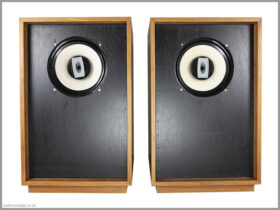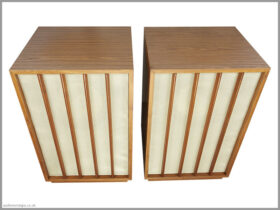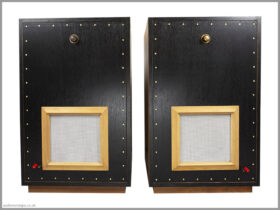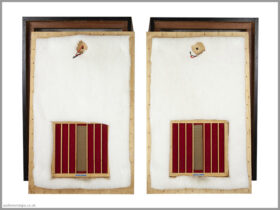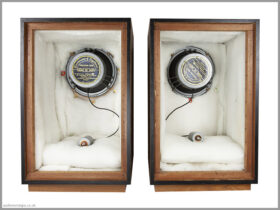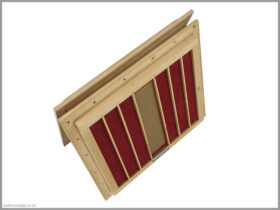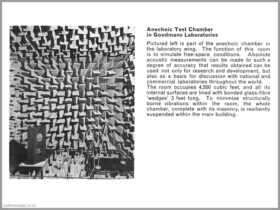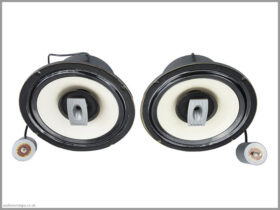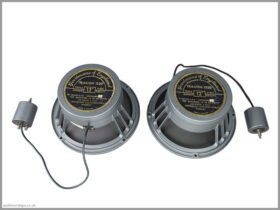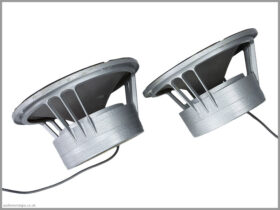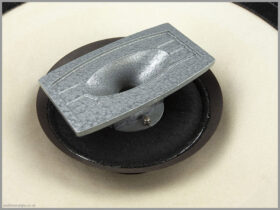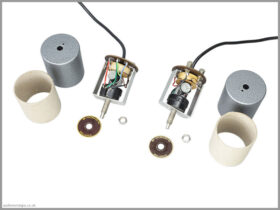TABLE OF CONTENTS
MY STORY WITH GOODMANS TRIAXIOM 1220C
I blame Tannoy for my excitement about coaxial speakers and Celestion for my passion for vintage HiFi (you can read more about it here). I came across Goodmans Triaxiom 1220c over 15 years ago. I was really allured by their look and by the nostalgia associated with speakers from the 1960s. At the time, I managed to purchase a set in nice condition and I built some temporary enclosures for them. I was somewhat disappointed with their performance, so I boxed them up and put them in storage.
Fast forward to 2023, when I came across some decent cabinets for these drivers with their proprietary ARUs (Goodmans’ name for the acoustic vent, aka Variovent). That triggered my memory and encouraged me to take the drivers out of storage and give them another chance, in these very period appropriate enclosures.
Please note – Before reviewing these speakers I have replaced capacitors in the crossovers. The original capacitors were way out of spec, which is expected considering their age. Due to this, my views regarding these Goodmans Triaxion 1220c speakers are based on listening to them after the upgrade. Also, bear in mind that purchasing vintage speakers is always a gamble. 60 years is a long time, and one can never be sure how this time affected the loudspeaker drivers. Consequently, even if you upgrade the crossover components, it is possible that your Goodmans Triaxiom 1220c drivers will measure and sound different than the pair I reviewed.
SPEAKER INFO
History
At some point in their existence, Goodmans was the largest loudspeaker manufacturer in Europe with their very own anechoic chamber (see the images below). These days, the Goodmans name is stamped on anything from cheap portable music devices to TVs. Not surprisingly, many people these days associate Goodmans with poor quality. However, this wasn’t always the case, and in their glory years Goodmans made some quality products.
Please bear in mind that in 1950s and 1960s, the Hi-Fi market wasn’t the same as it is today. There were very few companies offering finished loudspeakers. Frequently, you had to purchase drivers and crossovers separately, and then build your own cabinets based on plans provided by the manufacturer.
This was indeed the case with the Goodmans Triaxiom 1220c. As you can see in the scan of their brochure, there were a couple of enclosure options suggested by Goodmans. It is worth noting that due to driver design (lightweight cone, high efficiency) in order to get some decent bass response, a really large cabinet was required, and this is indeed reflected in enclosure plans provided by Goodmans.
Driver’s Design
Goodmans Triaxiom 1220c is a coaxial driver, meaning that both the woofer and tweeter share the same axis. This was a popular trend during that era, and different manufacturers tried that approach – Tannoy, Altec, Coral to name a few. Goodmans tried to market these loudspeakers as 3 way drivers, hence the presence of “tri” in the name. Because there is a whizzer cone attached to the woofer, they marketed that as the midrange driver. From a technical point of view, these are really 2 way drivers. We have a 12in cone and a horn tweeter bolted in the middle of the driver.
GOODMANS TRIAXIOM 1220C SPECS
| Frequency Response: | 30 – 20,000Hz (+/- 6dB) |
| Sensitivity: | Unknown |
| Impedance: | 8Ω |
| Power Capacity: | 20W |
| High Frequency Driver: | Horn Loaded 25mm (1″) Aluminium Diaphragm |
| Low Frequency Driver: | 300mm (12″) Vacuum Formed Paper Diaphragm |
| Crossover Frequency: | 5,000Hz |
| Free Air Resonance (FS): | 35Hz |
| Weight: | 8.45kg (each driver) |
| Production Year: | 1964 |
| Price When Launched: | £36 for a pair |
| Equivalent Present Day Price: | £600 for a pair |
| Current UK Price: | £300 to £500 for a pair |
LOOK & FEEL OF GOODMANS TRIAXIOM SPEAKERS
The whole driver looks very hefty, especially in comparison to modern drivers with plastic or pressed steel baskets. Here we have a cast metal basket that wraps around the magnet assembly and gives an impression of a larger motor structure than what it is in reality.
The woofer cone is made from paper, covered with some sort of lightweight foam. The texture of it reminds me of expanding foam. The cone surround is made of some sort of elastic plastic. It’s definitely not rubber. It is slightly wrinkled in places, but there are no other signs of deterioration. It has lasted 60 years and it is likely to last another 60. The tweeter is a small diameter bullet, hosted in a rather beefy metal horn, which goes nicely with the rest of the design. The crossover too is enclosed in a beefy metal can.
Overall, I’m pretty impressed with the build quality of these drivers.
SOUND OF GOODMANS TRIAXIOM 1220C
First Impressions
When I connected these drivers for the first time – two things caught my attention: more bass than I expected and lack of upper registers. In the enclosures that I was testing these speakers, the drivers were mounted with their tweeters way below the listening axis. I have therefore tilted the speakers up to point the tweeters directly at my ears. This helped a little, but the feeling of missing treble and air did not really go away.
Bass
This is where the 1220c surprised me a little because even though they are 12in drivers in relatively large cabinets, they have rather light diagrams and low q, so I wasn’t expecting extended low end. It turns out that the drivers are capable of a fair bit of bass. We of course don’t get a subwoofer level bass and on songs such as Old Love by Eric Clapton, I could not hear the low level foot tapping / wooden board rumble that I’m accustomed to hearing on full range systems. However, I’d expect most of the listeners to be satisfied with the amount of bass these drivers produce in large enclosures. It is worth noting that even though the bass instruments sound OK in isolation, when you have multiple things playing at the same time, it is not easy to tell them apart as the sound gets a little congested. Thus, the amount of bass we get is decent but the resolution of it not so much. What surprised me though is how effortless these speakers sound – you can tell that you are listening to large speakers. Moreover, Goodmans Triaxiom 1220c are a lot more efficient than a lot of modern speakers. I’ve noticed that the amp was set to about 6dB less than when I normally play music. Just bear in mind that power handling is rather low, and being completely honest, I did not dare to turn them up too high to test how they handle disco levels. However, if you are looking at these drivers, it is unlikely that this is what you are going to be using them for.
Even though this has nothing to do with the drivers, it is worth noting that Goodmans ARUs (acoustic vents produced by Goodmans) are mechanically a terrible design because they rattle. The outside metal mesh can vibrate creating quite a lot of noise when the speakers are playing low frequencies. This is easily noticeable on tracks such as Keep The Wolves Away by Uncle Lucius. So if you are planning to build speaker cabinets for these drivers and you are thinking of using Goodmans ARUs – think again. With a bit of work, you could probably make a device that behaves much better than these.
Midrange, Treble, and Soundstage
Enough about the bass though, let’s explore midrange and treble. Here things get even less exciting. Voices sound OK, but I constantly feel that something is missing in the upper registers which makes Goodmans Triaxiom 1220c sound muffled. As a result you don’t really get any spatial cues of where the recording took place. This also negatively affects reproduction of guitars where the body of the guitar sounds pleasant but the sparkle is missing at the top. And things important for live recordings, such as clapping, also suffer as a result of this behaviour. All of this is noticeable on tracks such as I Will Always Be Right There by Bryan Adam from the MTV Unplugged album.
Things such as soundstage are not great either. It is hard to get any illusion of depth or sense of sound source location within the sound stage. Because of this, in combination with the previously described lack of upper registers, it is rather hard to get involved in the listening. For instance, with speakers such as Magnepan LRS, you play something and you are immediately drawn into the music. As soon as one track ends, you want to listen to another. This is not the case with Goodmans Triaxiom 1220c. Saying that, there are some tracks that suit these speakers more than others. One of them is Dust In The Wind by Kansas which sounds quite good, but this is more of an exception than the norm. Although 1220c sound pleasant enough when playing in the background, I could not really engage during critical listening. Furthermore, more complicated recordings are a challenge too, and I’d Do Anything for Love (But I Won’t Do That) by Meat Loaf demonstrates this shortcoming very well.
You could probably get more out of these drivers with re-designed crossovers but I doubt the difference will be significant enough to justify the effort.
CONCLUSION
I really like the way these drivers look and the nostalgia associated with them, but the sound leaves a great deal to be desired. At the time of this review they are nearly 60 years old, and even though the principle of how the loudspeaker driver works has remained the same since then, there has been a lot of progress in the material science and our understanding of acoustics. If you are a vintage loudspeaker collector, then these 1220c are a fantastic piece of audio history. However, if you are after high fidelity sound, we can do much better these days.
| Balance of Sound: | |
| Neutrality of Tone: | |
| Transparency: | |
| Soundstage: | |
| Attack: | |
| Engagement: | |
| Total Score: |
SONGS MENTIONED IN THIS REVIEW
Bryan Adams – I Will Always Be Right There (MTV Unplugged)
Eric Clapton – Old Love (MTV Unplugged)
Kansas – Dust In The Wind
Meat Loaf – I’d Do Anything for Love (But I Won’t Do That)
Uncle Lucius – Keep The Wolves Away
Reviewed: August 2023 | Published: August 2024


